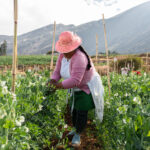Agronometrics in Charts: Chilean table grape industry catapulting towards a significant milestone this season

In this installment of the ‘Agronometrics In Charts’ series, Sarah Ilyas studies the state of the Chilean table grape season. Each week the series looks at a different horticultural commodity, focusing on a specific origin or topic visualizing the market factors that are driving change.
Chile's table grape exports through week 5 amounted to 8.9 million boxes of 8.2 kg, which is 5% less than the same point in the previous season. Compared to last season, exports to the United States are 8.0% lower. The dry climate and drought conditions contributed to the lower forecast.
While volumes are down, Chile is still in the process of upgrading to newer, higher-yielding grape varieties. In an effort to increase the competitiveness of Chilean grapes in worldwide markets, the Chilean table grape industry began promoting the cultivation of new table grape varieties a decade ago. This season will be a significant milestone, 53% of the export volume this season will comprise of new cultivars for the first time.
"Shipments are projected to reach 67.1 million boxes of 8.2 kilos. A figure that shows a 9.7% drop with respect to the 2021-2022 season, and a slight decrease with respect to the Committee's fourth estimate of almost 1%," says ASOEX’s president, Ivan Marambio.
The executive noted that quality remained a top priority for the industry. Exports of new red varieties, including Timco, Allison, Sweet Celebration, Scarlotta Seedless, Arra 29, Jack Salute, Candy Hearts, and Ralli Seedless, are anticipated to reach 18.4 million cases. 13.6 million cases of new white grapes, including Arra 15, Timpson, Sweet Globe, Autumn Crisp, Blanc Seedless, and Cotton Candy, are anticipated to be shipped. Exports of new black grape varieties, including Sweet Flavors, Sable Seedless, Sapphire, Maylen, and Midnight Beauty, are anticipated to reach 4,4 million cases.
For Chile, the post-harvest period is of critical importance. Compared to other grape exporters, where the fruit is no more than two or three days from the point of consumption, Chilean grapes take four weeks to arrive. “We have reformulated our usual harvesting and packing practices to reduce dehydration and premature deterioration of fruit and stalks,” says Carolina Cruz, President of industry association, Uvanova.
Novel varieties are beneficial for both consumers and farmers. On the one hand, the majority of them are extremely fertile, ensuring higher yields per hectare and easier management, and obtaining more independence from growth regulators to increase size and color.
From the standpoint of the customer, they provide larger sizes, higher sweetness, and a variety of flavors, as well as vivid and appealing shapes and colors. “This year we may not be the largest exporter of grapes to the world, but we are sure that we will continue to offer a product with very good organoleptic quality, tasty to eat, healthy, and sustainable,” says Cruz.
 Source: USDA Market News via Agronometrics.
Source: USDA Market News via Agronometrics.
(Agronometrics users can view this chart with live updates here)
“Chile loses attractive market windows every year. The country’s production overlaps with many other grape growing countries,” says Antonio Escobar of Divine Flavor. First off, Chile’s season begins at the same time as that of Peru, a country that takes a larger part of the North American market.
Mexico enters the market towards the conclusion of the Chilean season and reaps the benefits of its proximity to the US. Peru not only benefits from cultivating a greater proportion of novel varieties, but grapes from the nation can also enter the US without being fumigated. “Chile is now pushing for a Systems Approach that would allow the fruit to arrive without fumigation,” shares Antonio Escobar of Divine Flavor. “This could be key for Chilean grapes as it would improve the quality of the fruit upon arrival,” adds Escobar.
 Source: USDA Market News via Agronometrics.
Source: USDA Market News via Agronometrics.
(Agronometrics users can view this chart with live updates here)
In our ‘In Charts’ series, we work to tell some of the stories that are moving the industry. Feel free to take a look at the other articles by clicking here.
All pricing for domestic US produce represents the spot market at Shipping Point (i.e. packing house/climate controlled warehouse, etc.). For imported fruit, the pricing data represents the spot market at Port of Entry.
You can keep track of the markets daily through Agronometrics, a data visualization tool built to help the industry make sense of the huge amounts of data that professionals need to access to make informed decisions. If you found the information and the charts from this article useful, feel free to visit us at www.agronometrics.com where you can easily access these same graphs, or explore the other 21 commodities we currently track.














































